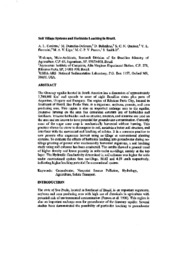Soil tillage systems and herbicide leaching in Brazil.
Soil tillage systems and herbicide leaching in Brazil.
Autoria: CERDEIRA, A. L.; SOUZA, M. D. de; BOLONHEZI, D.; QUEIROZ, S. C. do N. de; FERRACINI, V. L.; LIGO, M. A. V.; PESSOA, M. C. P. Y.; SMITH JR, S.
Resumo: The Guarany aquifer located in South America has a dimension of approximately 1,200,000 Km2 and spreads to areas of eight Brazilian states plus parts of Argentina, Uruguay and Paraguay. The region of Ribeirao Preto City, located in Southeast of Brazil, Sao Paulo State, is a sugarcane, soybean, peanuts, and corn producing area. This region is also an important recharge area to the aquifer. Intensive farming on the area has demanded constant use of herbicides and fertilizers. Triazine herbicides such as atrazine, ametryn, and simazine are used on the area and are known to have potential for groundwater contamination. Currently most of the sugar cane crop is mechanically harvested without burning. This practice allows the straw to decompose in soil, maintain a better soil structure, and interferes with the movement and leaching of solutes. It is a common practice to sow peanuts after sugarcane harvest using no-tillage or conventional planting systems. To evaluate the effects of herbicide leaching into groundwater during notillage planting of peanut after mechanically harvested sugarcane, a soil leaching study using soil columns has been conducted. The results showed a general trend of higher density and lower porosity in soils under no-tillage, mainly at the top layer. The Hydraulic Conductivity determined in soil columns was higher for soils under conventional system than no-tillage, 10.82 and 4.59 cm/h respectively,indicating higher leaching potential for conventional system.
Ano de publicação: 2005
Tipo de publicação: Artigo em anais e proceedings
Unidade: Embrapa Meio Ambiente
Palavras-chave: Groundwater, Hidrologia, Hydrology, Nonpoint source pollution, Soil transport processes, Águas subterrâneas
Observações
1 - Por padrão são exibidas publicações dos últimos 20 anos. Para encontrar publicações mais antigas, configure o filtro ano de publicação, colocando o ano a partir do qual você deseja encontrar publicações. O filtro está na coluna da esquerda na busca acima.
2 - Para ler algumas publicações da Embrapa (apenas as que estão em formato ePub), é necessário ter, no celular ou computador, um desses softwares gratuitos. Sistemas Android: Google Play Livros; IOS: iBooks; Windows e Linux: software Calibre.
Acesse outras publicações
Acesse a Base de Dados da Pesquisa Agropecuária (BDPA) para consultar o acervo completo das bibliotecas da Embrapa.

